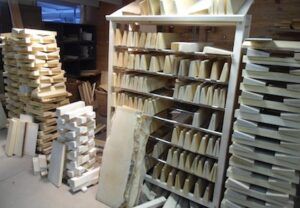Last week I was in Germany and North Italy buying spruce and maple for the next few years of violin making. A colleague and I first visited the wood dealer Bachmann in Italy, where we bought spruce. In their store room they had hundreds of pieces of spruce which was carefully organized. Every piece of wood was numbered on the end, giving the year it was cut and a number for the actual tree. (see below)
This saved us a huge amount of time and though the store room was unheated, it was great to look through all this wood. Once we found a ‘tree’ that we liked, we could go through that section and make our final choice.
The next day we visited Mittenwald in Germany and bought maple for the violin backs, sides and necks and some extra spruce too. The two wood dealers we visited in Mittenwald were not so carefully organized. We searched through stacks of wood (some pictured below) to find the pieces we liked. We were then careful to restack the wood more or less as we found them. They don’t appreciate violin makers visiting and leaving their wood in a complete mess! By visiting different wood dealers I was pleased to find an excellent stock of maple and spruce for my next instruments.
A few criteria we were using to choose, for example the spruce, were:
Density – we measured the volume and weighed the wood to calculate the density. We were generally looking for lighter wood.
Correctly cut – Some wood is split from the logs and this guarantees that the fiber of the wood runs straight through the length of each piece of wood. The wood we were buying was sawn, which is a more efficient way to cut up the logs. But we had to check that the ‘split’ was running straight through each piece. If it’s not cut correctly, the wood will effectively be weaker among other issues.
The grains in the wood – This is a matter of taste and each maker will have different ideas on this. I copy certain old Italian instruments and so I was looking for a width and type of grain that was close to the original instruments I copy.
A great deal more could be written on choosing spruce or maple but above are a few of the basic criteria we were looking for. As we searched through hundreds of pieces of wood, we tried to set high standards and were often rejecting 98% to 99% of what we saw. On the other hand during our trip we ate well and enjoyed 99% of the tasty food we found. If only seaching for good wood was so easy!



